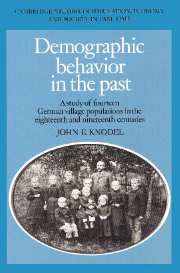 Demographic Behavior in the Past
Demographic Behavior in the Past Book contents
- Frontmatter
- Contents
- List of tables
- List of figures
- Acknowledgements
- PART I INTRODUCTION
- PART II MORTALITY
- PART III FAMILY FORMATION
- PART IV MARITAL REPRODUCTION
- PART V INTERRELATIONSHIPS IN DEMOGRAPHIC BEHAVIOR
- PART VI CONCLUSION
- Appendices
- A Selection of couples for analysis
- B Assessment of the quality of demographic data contained in German village genealogies
- C Local village conditions
- D The occupational and status classification schemes
- E Calculation of infant and child mortality risks
- F Prevailing infant-feeding patterns
- G Evidence of biases in the determination of legitimization status
- Bibliography
- Index
F - Prevailing infant-feeding patterns
Published online by Cambridge University Press: 04 August 2010
- Frontmatter
- Contents
- List of tables
- List of figures
- Acknowledgements
- PART I INTRODUCTION
- PART II MORTALITY
- PART III FAMILY FORMATION
- PART IV MARITAL REPRODUCTION
- PART V INTERRELATIONSHIPS IN DEMOGRAPHIC BEHAVIOR
- PART VI CONCLUSION
- Appendices
- A Selection of couples for analysis
- B Assessment of the quality of demographic data contained in German village genealogies
- C Local village conditions
- D The occupational and status classification schemes
- E Calculation of infant and child mortality risks
- F Prevailing infant-feeding patterns
- G Evidence of biases in the determination of legitimization status
- Bibliography
- Index
Summary
Infant-feeding practices, particularly the prevalence and duration of breastfeeding, are an important determinant of infant mortality in situations where modern hygienic conditions are lacking, and an important determinant of fertility where deliberate birth control is not practiced. Fortunately some information is available on breastfeeding for a number of areas in Germany, at least for the end of the period covered by the present study. There can be no question that sharp regional differences in breastfeeding existed around 1900. Moreover, there is some limited evidence that many of the regional patterns had existed for a considerable period in the past. While the quantity and quality of information varies for the areas in which the sample villages are located, at least some indication of the pattern prevailing around 1900 is available for all. In addition, indirect evidence can be derived from the reproductive histories of couples in the village genealogies. In brief, the evidence indicates that the three Bavarian villages are located in areas where it was not common to breastfeed at all or to breastfeed for only very short durations. In all the areas where the other sample villages are located, breastfeeding appears to have been the general rule, although differences with respect to duration were probably substantial. Fairly prolonged breastfeeding appears to have been most common in Waldeck and East Friesland, while more moderate breastfeeding characterized the areas of Baden and Württemberg where the sample villages are located.
- Type
- Chapter
- Information
- Demographic Behavior in the PastA Study of Fourteen German Village Populations in the Eighteenth and Nineteenth Centuries, pp. 542 - 549Publisher: Cambridge University PressPrint publication year: 1988


